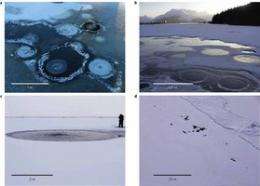May 21, 2012 report
Environmental group measures methane seeps in the Arctic

(Phys.org) -- A team of researchers, led by Katey Walter Anthony, of the University of Alaska, has been studying and mapping so-called seeps, holes in lake ice near the edges of glaciers where methane is bubbling up from below into the atmosphere, and suggest that a feedback loop may be in the works. As the team writes in their paper describing their observations, which has been published in the journal Nature Geoscience, seeping methane that results from Arctic warming, might itself also be contributing to warming; a feedback loop that could accelerate global warming.
Methane is considered by most Earth scientists to be number two on the list of greenhouse gasses that contribute to global warming, after CO2, and because of that more research is being done with the hopes of finding where all of it is coming from. It generally forms when organic matter decays or is digested and thus known sources include animal exhaust, including from humans, melting of permafrost, waste from landfills and decaying matter beneath the floor of the world’s oceans. Now, based on this new research it appears another significant source is seeps from lakes formed by glaciers.
Scientists believe that when glaciers formed they trapped organic matter beneath them. Later as lakes formed at their edges, methane began to be produced as the organic matter rotted. That methane remained trapped however, until recently, by the cap of ice that remained on the surface of such lakes. Now, in the past decade, with the rise in Arctic temperatures, seeps have developed allowing the methane to slowly escape into the atmosphere. The team has mapped, using both aerial and ground based surveys, 150,000 such seeps in Alaska and Greenland alone.
Scientists monitoring methane in the atmosphere have found that levels of the gas rose predictably in the latter half of the last century, then for unknown reasons, leveled off for about five years, and then resumed rising again. Because of this, researchers are concerned, as it’s thought that the Arctic, which is experiencing warming at a faster pace than anywhere else on the planet, could be entering a phase where because of feedback loops such as these seen with methane (and with carbon emissions from melting permafrost) we’re on a course that could see global warming occur on a much faster pace than has been previously anticipated. Others of course suggest that because we still don’t really understand how the whole system works, making any sort of prediction at this point would be premature.
More information: Geologic methane seeps along boundaries of Arctic permafrost thaw and melting glaciers, Nature Geoscience (2012) doi:10.1038/ngeo1480
Abstract
Methane, a potent greenhouse gas, accumulates in subsurface hydrocarbon reservoirs, such as coal beds and natural gas deposits. In the Arctic, permafrost and glaciers form a ‘cryosphere cap’ that traps gas leaking from these reservoirs, restricting flow to the atmosphere. With a carbon store of over 1,200 Pg, the Arctic geologic methane reservoir is large when compared with the global atmospheric methane pool of around 5 Pg. As such, the Earth’s climate is sensitive to the escape of even a small fraction of this methane. Here, we document the release of 14C-depleted methane to the atmosphere from abundant gas seeps concentrated along boundaries of permafrost thaw and receding glaciers in Alaska and Greenland, using aerial and ground surface survey data and in situ measurements of methane isotopes and flux. We mapped over 150,000 seeps, which we identified as bubble-induced open holes in lake ice. These seeps were characterized by anomalously high methane fluxes, and in Alaska by ancient radiocarbon ages and stable isotope values that matched those of coal bed and thermogenic methane accumulations. Younger seeps in Greenland were associated with zones of ice-sheet retreat since the Little Ice Age. Our findings imply that in a warming climate, disintegration of permafrost, glaciers and parts of the polar ice sheets could facilitate the transient expulsion of 14C-depleted methane trapped by the cryosphere cap.
Journal information: Nature Geoscience
© 2012 Phys.Org



















